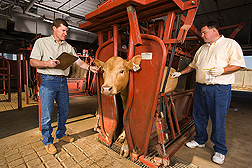This page has been archived and is being provided for reference purposes only. The page is no longer being updated, and therefore, links on the page may be invalid.
Read the magazine story to find out more. | |
|
Hide-Washing Improves Beef Safety
By Laura McGinnisOctober 4, 2006
A practical, effective cattle-washing system that reduces levels of pathogens on cattle hides—lessening the likelihood that the pathogens will get onto the meat and be consumed by humans—has been developed by Agricultural Research Service (ARS) scientists in Clay Center, Neb.
The system could help reduce pathogens such as Escherichia coli O157:H7, which causes nearly 73,000 illnesses and 60 deaths every year, according to the Centers for Disease Control and Prevention (CDC).
Although E. coli O157:H7 can harm humans, cattle can carry it without adverse effects, according to researchers at the ARS Roman L. Hruska U.S. Meat Animal Research Center (USMARC) in Clay Center. ARS research showed that the pathogens tend to gather on the animals' hides, which becomes a problem if those bacteria then come into contact with meat during hide removal.
In the hide-washing process, the hide-on carcass is cleaned in a high-pressure water washing cabinet to remove excess organic matter, then sprayed with an antibacterial compound. In field trials, the process significantly reduced the number of samples that tested positive for E. coli O157:H7.
USMARC Director Mohammad Koohmaraie estimates that about 40 percent of the feedlot- raised beef cattle processed in the United States now undergo hide-on carcass-washing treatment, a development that benefits both beef companies and consumers.
The U.S. Department of Agriculture's Food Safety and Inspection Service reported that the incidence of E. coli O157:H7-positive ground beef samples collected fell by 43.3 percent after the beef industry began using the washing cabinets. The CDC also noted significant reductions in illnesses caused by E. coli and the pathogens Listeria, Campylobacter, Yersinia and Salmonella.
Read more about this research in the October 2006 issue of Agricultural Research magazine, which highlights ARS food safety research.
ARS is the USDA's chief scientific research agency.


